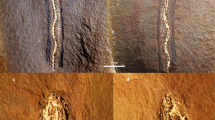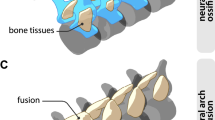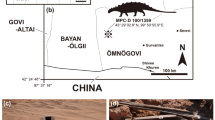Abstract
The earliest four-limbed vertebrates, or tetrapods, lived between 370 million and 354 million years ago, during the Late Devonian period, and typically had more than five digits (polydactyly)1. We have discovered that a preaxial form of polydactyly, in which extra digits are positioned anterior to the first digit, has unexpectedly re-emerged in a marine reptile from the Early Triassic period about 242 million years ago — the overall morphology of both the manus and pes closely resemble those of the earliest tetrapods. Until now, no post-Devonian tetrapod has been found with a comparative type of polydactyly, so the new amniote provides a striking example of convergent evolution.
Similar content being viewed by others
Main
The new amniote is a marine reptile from Hubei Province in China (amniotes include reptiles, birds and mammals). Its most remarkable feature is the number of its digits: the forelimbs bear seven and the hindlimbs have six (Fig. 1). The extra digits on both fore- and hindlimbs are well developed and the bones are arranged normally as distal carpal/tarsal (distal carpals 3 and 4 are fused as a single large carpal in the forelimb of the new amniote), metacarpal/metatarsal and phalanges (see supplementary information).
It is represented by the part and counterpart of an almost complete skeleton from which the anterior end of the snout and the tail tip are missing. The specimen was collected from the marine Jialingjiang Formation (late Early Triassic11) near Xunjiansi, Nanzhang County, Hubei Province, China. Taxonomically, SSTM 5025 is referred to Nanchangosauridae, Wang, 1959 of Hupehsuchia Young & Dong, 1972 in Diapsida Gauthier et al., 1988 of Reptilia Gauthier et al., 1988. Further details are available from X.-C. W. Scale bar, 10 cm.
Ichthyosaurs of the Mesozoic era (250–65 million years ago) had porpoise-like bodies, with dorsal and tail fins and often polydactylous limbs. This polydactyly, however, was quite different from that of the Devonian tetrapods. Modern pandas and moles2, humans2,3 and cats4 occasionally have extra preaxial digits, but these are rarely morphologically or structurally comparable with a normal digit2,3,5.
Almost all polydactyly in tetrapods can be referred to one of three types. In postaxial polydactyly, the extra digits are posterior to digit V, as seen in the Late Devonian Tulerpeton6, some frog individuals and even humans2,3. In preaxial polydactyly, the extra digits are anterior to digit I, as seen in the fore- and hindlimbs of the new amniote, and in the hindlimbs of the Late Devonian Ichthyostega and forelimbs of the Late Devonian Acanthostega1. In bilateral polydactyly, the extra digits are anterior to digit I and posterior to digit V, as seen in the forelimbs of the ophthalmosaurian ichthyosaurs7 and today in some polydactylous Indian families3; the extra digits on the hindlimbs of the Devonian Acanthostega8 also appear to be of this type.
Other types of polydactyly can occur, for example in the forelimbs of many non-ophthalmosaurian ichthyosaurs7. Most occur by interdigital or postaxial phalangeal bifurcation7. Of the known polydactylous tetrapods, the new amniote is the only one that has both fore- and hindlimbs that are preaxially polydactylous, matching the current limb-development model9 (see supplementary information).
The new amniote was a secondarily aquatic reptile and its polydactylous limbs are derived from adaptation to its aquatic life. Its manus and pes are short and wide, and generally resemble those of the Late Devonian Ichthyostega and Acanthostega. They are also comparable in shape to the limb-like paired fins of extant frogfishes8,10. The limbs of this amniote may have functioned in a similar way to those of the Devonian tetrapods or to the paired fins of frogfishes when moving across underwater substrates. In its morphology and way of life, the new amniote provides a good example of evolutionary convergence with the earliest tetrapods, as well as an analogy with frogfishes in vertebrate evolution.
References
Coates, M. I. & Clack, J. A. Nature 347, 66–69 (1990).
Gould, S. J. Nat. Hist. 1/91, 22–29 (1991).
Radhakrishna, U. et al. Am. J. Genet. 65, 645–655 (1999).
Danforth, C. H. Am. J. Anat. 80, 143–171 (1947).
Shubin, N., Tabin, C. & Carroll, S. Nature 388, 639–648 (1997).
Lebedev, O. A. Doklady Academii Nauk SSSR 278, 1470–473 (1984).
Motani, R. J. Vert. Paleontol. 19, 28–41 (1999).
Clack, J. Gaining Ground: The Origin and Evolution of Tetrapods (Indiana Univ. Press, Bloomington, 2002).
Shubin, N. H. & Alberch, P. Evol. Biol. 20, 319–387 (1986).
Edwards, J. J. Am. Zool. 29, 235–254 (1989).
Li, J.-L., Liu, J., Li, C. & Huang, Z.-X. Vert. PalAsiat. 40, 241–244 (2002).
Author information
Authors and Affiliations
Corresponding author
Ethics declarations
Competing interests
The authors declare no competing financial interests.
Additional information
brief communications is intended to provide a forum for brief, topical reports of general scientific interest and for technical discussion of recently published material of particular interest to non-specialist readers (communications arising). Priority will be given to contributions that have fewer than 500 words, 10 references and only one figure. Detailed guidelines are available on Nature's website (http://www.nature.com/nature).
Supplementary information
41586_2003_BF426516a_MOESM1_ESM.jpg
Supplementary Figure: Limbs of SSTM 5025. A, Right forelimb. B, Right hindlimb. C. A hypothesized pattern of developmental conectivities in the limbs of SSTM 5025 (after Shubin and Alberch10). Abbreviations: as, astragalus; ca, calcaneum; cen, centrale; cl, lateral centrale; cm, medial centrale; Fi, fibula; H, humerus; in, intermedium; R, radius; ra, radiale; U, ulna; ul, ulnare; I, II, III, V, metacarpals/metatarsals I, II, III and V; II’, second extra metacarpal; I’, an extra metatarsal anterior to metatarsal I; 3+4, fused distal carpals 3 and 4; 1, 4, distal tarsals 1 and 4. Further details are available as from X.-C. Wu (xcwu@mus-nature.ca). (JPG 82 kb)
Rights and permissions
About this article
Cite this article
Wu, XC., Li, Z., Zhou, BC. et al. A polydactylous amniote from the Triassic period. Nature 426, 516 (2003). https://doi.org/10.1038/426516a
Issue Date:
DOI: https://doi.org/10.1038/426516a
This article is cited by
-
Evidence for an amphibian sixth digit
Zoological Letters (2015)
-
Cretaceous choristoderan reptiles gave birth to live young
Naturwissenschaften (2010)
Comments
By submitting a comment you agree to abide by our Terms and Community Guidelines. If you find something abusive or that does not comply with our terms or guidelines please flag it as inappropriate.




